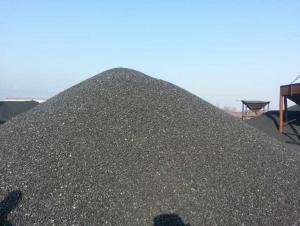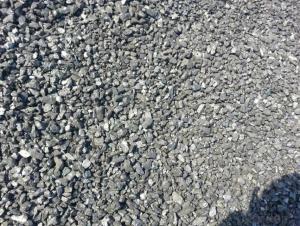Recarburizer FC90% -95% for steel making
- Loading Port:
- Tianjin
- Payment Terms:
- TT OR LC
- Min Order Qty:
- 20 m.t.
- Supply Capability:
- 3000 m.t./month
OKorder Service Pledge
OKorder Financial Service
You Might Also Like
Packaging & Delivery
25kgs/50kgs/1ton per bag or as buyer's request
Specifications
Calcined Anthracite
Fixed carbon: 90%-95%
S: 0.5% max
Size: 0-3. 3-5.3-15 or as request
It used the high quality anthracite as raw materials through high temperature calcined at over 2000 by the DC electric calciner with results in eliminating the moisture and volatile matter from anthracite efficiently, improving the density and the electric conductivity and strengthening the mechanical strength and anti-oxidation. It has good characteristics with low ash, low resistvity, low sulphur, high carbon and high density. It is the best material for high quality carbon products.
Advantage and competitive of caclined anthracite:
1. strong supply capability
2. fast transportation
3. lower and reasonable price for your reference
4.low sulphur, low ash
5.fixed carbon:95% -90%
6..sulphur:lower than 0.3%
General Specification of Calcined Anthracite:
| FC | 95 | 94 | 93 | 92 | 90 |
| ASH | 4 | 5 | 6 | 6.5 | 8.5 |
| V.M. | 1 | 1 | 1 | 1.5 | 1.5 |
| S | 0.3 | 0.3 | 0.3 | 0.35 | 0.35 |
| MOISTURE | 0.5 | 0.5 | 0.5 | 0.5 | 0.5 |
Pictures

- Q:How does carbon affect the formation of desertification?
- The formation of desertification is not directly affected by carbon. Rather, desertification is primarily caused by a combination of natural factors, such as climate change, prolonged drought, and human activities like deforestation and overgrazing. However, carbon does play an indirect role in exacerbating desertification through climate change. Carbon dioxide (CO2), a greenhouse gas, is released into the atmosphere through human activities, particularly the burning of fossil fuels. The increased concentration of CO2 in the atmosphere leads to global warming, which alters climate patterns and increases the frequency and intensity of droughts. Prolonged droughts deplete soil moisture, making the land more susceptible to erosion and degradation, thus contributing to the desertification process. Furthermore, carbon indirectly affects desertification through deforestation. Trees and other vegetation play a vital role in maintaining healthy soil by preventing erosion, retaining moisture, and providing shade. When forests are cleared, the carbon stored in trees is released into the atmosphere, contributing to higher CO2 levels. Additionally, the loss of vegetation cover exposes the soil to erosion by wind and water, which accelerates desertification. It is important to acknowledge that while carbon indirectly impacts desertification through climate change and deforestation, desertification itself is a complex process influenced by various factors. Addressing desertification requires a comprehensive approach involving sustainable land management practices, reforestation efforts, water management, and strategies to mitigate climate change.
- Q:What is the burning point of carbon?
- There are many forms of carbon, such as charcoal, coal, and even diamonds!And different forms have different ignition points!Generally speaking, the ignition point of charcoal is relatively low, about 300 degrees, and the coal is higher, at 600 - 700 degrees!
- Q:What is the boiling point of carbon?
- The boiling point of carbon is approximately 4,827 degrees Celsius (8,740 degrees Fahrenheit).
- Q:What is carbon PC?
- Polycarbonate (PC), polycarbonate is a molecular chain containing [O-R-O-CO] chain thermoplastic resin according to the molecular structure of the ester can be divided into aliphatic, alicyclic and aromatic type of fat, which has the practical value of the aromatic polycarbonate, and bisphenol A polycarbonate as the most important, molecular weight is usually 3-10 million.Polycarbonate, English Polycarbonate, referred to as PC.PC is a kind of amorphous, odorless, non-toxic, highly transparent colorless or slightly yellow thermoplastic engineering plastics, has excellent physical and mechanical properties, especially excellent shock resistance, tensile strength, bending strength, compressive strength and high creep; small size is stable; good heat resistance and low temperature resistance, mechanical properties, stability in a wide range of temperature dimensional stability, electrical properties and flame retardant properties, can be used for a long time at -60~120 deg.c; no obvious melting point, a molten state at 220-230 DEG C; the molecular chain rigidity, melt viscosity and high water absorption resin; small, small shrinkage, high precision, good dimensional stability, permeability of films is small; self extinguishing materials; stable to light, but not UV resistance, good weather resistance; oil resistance, acid and alkali resistance, no oxygen acid and amine, Ketones are soluble in chlorinated hydrocarbons and aromatic solvents. They are easy to cause hydrolysis and cracking in water for a long time. Because of their poor fatigue resistance, they are prone to stress cracking, poor solvent resistance and poor wear resistance
- Q:How does carbon contribute to the hardness of steel?
- Carbon contributes to the hardness of steel through a process known as carbonization. When carbon atoms are introduced into the iron lattice of steel, they create interstitial solid solutions, causing the lattice to become distorted. This distortion prevents the iron atoms from sliding past each other easily, thereby increasing the resistance to deformation and making the steel harder. Increasing the carbon content in steel increases the strength and hardness, up to a certain limit. However, excessive carbon can also make the steel brittle, so it is important to find the right balance to achieve optimal hardness without compromising other properties of the steel.
- Q:Is carbon monoxide good for people?
- But in organ transplant operations, the use of trace amounts of carbon monoxide helps dilate blood vessels and reduce inflammation, thereby increasing the survival rate of transplanted organs. But traditional carbon monoxide inhalation has the risk of poisoning patients and medical staff by accidental inhalation of high doses of carbon monoxide. That's the advantage of CO
- Q:How is carbon used in the production of pigments?
- Carbon is commonly used in the production of pigments due to its ability to create vibrant and deep colors. Carbon-based pigments, also known as carbon blacks, are produced by the incomplete combustion of hydrocarbons, such as natural gas or petroleum. The carbon particles produced during this process are then processed and purified to create a fine powder that can be used as a pigment. These carbon-based pigments have a wide range of applications in various industries, including inks, paints, plastics, and cosmetics. In the production of inks, carbon black is often added to improve the color intensity and opacity of the ink. It is also used in the manufacturing of black pigments for paints and coatings, providing a rich and deep black color. Carbon-based pigments are also used in the production of plastics. Adding carbon black to plastic materials can enhance their UV resistance, making them more durable and long-lasting. This is particularly important in outdoor applications where exposure to sunlight can cause fading and degradation. Additionally, carbon-based pigments are commonly used in the cosmetics industry. They are added to various cosmetic products, such as eyeliners, mascaras, and lipsticks, to create intense black or dark shades. Carbon black pigments are preferred in cosmetics due to their stability and ability to deliver consistent color. In conclusion, carbon is widely used in the production of pigments due to its ability to create vibrant and deep colors. Carbon-based pigments find applications in various industries, including inks, paints, plastics, and cosmetics, where they enhance color intensity, provide UV resistance, and deliver rich black shades.
- Q:What is carbon offsetting in the energy sector?
- The energy sector engages in carbon offsetting by compensating for the greenhouse gas emissions generated from energy generation and consumption activities. This practice involves investing in projects that reduce or eliminate carbon dioxide (CO2) and other greenhouse gas emissions from the atmosphere. The main objective is to achieve a balance between the emissions released and the emissions reduced. Greenhouse gas emissions from the energy sector, particularly from the burning of fossil fuels like coal, oil, and natural gas, contribute significantly to global emissions. Carbon offsetting in this sector aims to mitigate the environmental impact of these emissions by financing projects that promote renewable energy, energy efficiency, and other measures to reduce carbon. There are various types of projects that can be supported through carbon offsetting in the energy sector. For instance, investments can be made in renewable energy projects such as wind farms, solar power plants, or hydropower facilities. These projects generate clean energy without emitting greenhouse gases and help replace fossil fuel-based energy sources, thus reducing overall emissions. Moreover, carbon offsetting can also support energy efficiency projects. These initiatives focus on reducing energy consumption by implementing energy-efficient technologies, improving insulation, or optimizing industrial processes. By reducing energy demand, these projects indirectly contribute to lower greenhouse gas emissions. Additionally, carbon offsetting in the energy sector can involve supporting initiatives that remove carbon dioxide from the atmosphere. These projects often include reforestation or afforestation efforts, which involve planting trees or restoring degraded forests. Trees absorb and store carbon dioxide through photosynthesis, thus offsetting emissions and combating climate change. In summary, carbon offsetting in the energy sector is crucial for transitioning towards a sustainable and low-carbon future. By investing in projects that reduce or eliminate greenhouse gas emissions, individuals, organizations, and governments can take responsibility for their carbon footprint and contribute to global efforts in addressing climate change.
- Q:How does carbon affect the formation of volcanic eruptions?
- Carbon plays a significant role in the formation of volcanic eruptions. When carbon-rich magma rises to the Earth's surface, it releases large amounts of carbon dioxide gas. This gas builds up pressure within the volcano, contributing to the explosive nature of volcanic eruptions. Additionally, carbon dioxide dissolved in the magma can cause the magma to become more fluid, making it easier for it to reach the surface and result in volcanic activity.
- Q:How does carbon affect the formation of landslides?
- Carbon does not directly affect the formation of landslides. However, the presence of carbon in the form of organic matter can contribute to the stability of slopes as it plays a role in soil structure and moisture retention.
1. Manufacturer Overview |
|
|---|---|
| Location | |
| Year Established | |
| Annual Output Value | |
| Main Markets | |
| Company Certifications | |
2. Manufacturer Certificates |
|
|---|---|
| a) Certification Name | |
| Range | |
| Reference | |
| Validity Period | |
3. Manufacturer Capability |
|
|---|---|
| a)Trade Capacity | |
| Nearest Port | |
| Export Percentage | |
| No.of Employees in Trade Department | |
| Language Spoken: | |
| b)Factory Information | |
| Factory Size: | |
| No. of Production Lines | |
| Contract Manufacturing | |
| Product Price Range | |
Send your message to us
Recarburizer FC90% -95% for steel making
- Loading Port:
- Tianjin
- Payment Terms:
- TT OR LC
- Min Order Qty:
- 20 m.t.
- Supply Capability:
- 3000 m.t./month
OKorder Service Pledge
OKorder Financial Service
Similar products
New products
Hot products




























